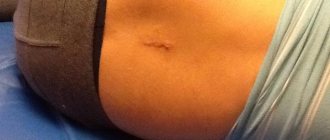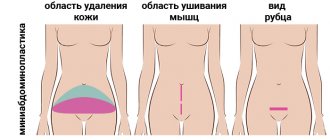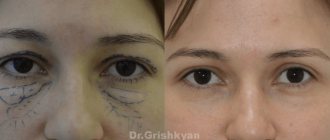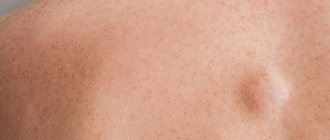An umbilical hernia appears as a protrusion in the navel area that disappears or decreases in size when you lie down.
An umbilical hernia may be accompanied by discomfort, abdominal pain, and nausea.
The main cause of this disease is the weakening of the umbilical ring and the formation of a hole in the anterior abdominal wall, through which internal organs (intestines, greater omentum) emerge under the skin.
An umbilical hernia develops more often in women, which is associated with stretching of the umbilical ring during pregnancy.
Other causes of umbilical hernia include heavy lifting, chronic constipation, and obesity.
Why is it necessary to treat an umbilical hernia?
The very appearance of a hernia indicates that the organs have changed their location, and their normal mutual pressure on each other has been disrupted. This leads to disruption of the functions of all organs involved in the formation of a hernia.
An umbilical hernia must be treated. It cannot “drag out” on its own, and will only progress over time.
Without effective treatment, even a small hernia significantly impedes the normal functioning of organs
Lack of treatment will eventually lead to serious complications
- coprostasis - stagnation of feces in the large intestine,
- inflammation of the hernia - inflammation of the organs located in the hernial sac,
- strangulation of the umbilical hernia - sudden compression of the hernial contents in the hernial orifice, leading to disruption of the blood supply to the organs in the hernial sac, and as a result - necrosis (death) of tissue.
An umbilical hernia is often accompanied by chronic constipation. Constipation, in turn, leads to general intoxication of the body and can affect the condition of the entire gastrointestinal tract.
If a protrusion appears on the anterior abdominal wall, you should immediately consult a doctor, since it is much easier to treat a fresh hernia than one that has existed for a long time.
- Surgery
- Oncology
- Neurosurgery
- Radiology and Radiation Therapy
- Gynecology and new reproductive technologies
- Traumatology and Orthopedics
- Cardiology
- Neurology
- Laser surgery
- Urology, andrology and microsurgery
- Plastic surgery
- Mammalogy
- Lithotripsy
- Psychological support service
- ECO
- Weight loss
- Pressure chamber
- Endovascular surgery
- Inguinal hernia
- Umbilical hernia
- Postoperative hernia
- Hernia of the white line of the abdomen
- Diastasis (divergence) of the rectus abdominis muscles
- Diaphragmatic hernia
- Large and giant hernias
Any, even the most successful, surgical intervention performed on the abdominal wall is fraught with the appearance of another serious problem - the development of a postoperative hernia. Abdominal wall hernias are one of the most common surgical pathologies. Operations on this occasion are carried out in almost any surgical department, and often in a day hospital. Despite this, large postoperative hernias are dangerous to the health and life of the patient and are a serious problem for the surgeon.
Is it possible to live with a hernia?
Can. But it’s bad, and in some cases not for long. How long can you wear a “backpack”, which causes great discomfort and is often life-threatening? Under the weight of this load, the normal breathing process is disrupted, heart function worsens, digestion suffers, back pain, posture is disrupted, and it becomes difficult to walk. Agree, the situation is bleak. But the most important thing is the high risk of strangulated hernia and intestinal obstruction. And this is a real danger. This is why hernias need to be operated on.
Waiting is no cure
Many of you hesitate to seek medical help for a long time, postponing a visit to the doctor day after day. And in vain. We categorically do not recommend delaying the operation! The longer you cannot part with your “favorite” burden, the more the muscles and tendons of the abdominal wall will become deformed. Gradually, the lateral abdominal muscles contract, diverge to the sides, and the muscle fibers are replaced by connective tissue. The muscles lose elasticity and extensibility, and the volume of the abdominal cavity decreases so much that it no longer accommodates the internal organs that were naturally located there before the development of the hernia. Now they are in the hernial sac, which outwardly looks like a large and unaesthetic protrusion, which greatly reduces a person’s quality of life. Let's not forget that this is dangerous.
In these cases, an attempt to simply “sut up the hernia” or even “put a mesh” is doomed to failure and is extremely dangerous, since after removing the hernial sac and repositioning the internal organs into the abdominal cavity, performing conventional hernioplasty (installation of a mesh covering the hernial orifice) can lead to the development abdominal compartment syndrome - a condition in which internal organs are compressed because their volume does not correspond to the volume of the abdominal cavity. As a result of this, their nutrition is disrupted, renal and respiratory failure develops, there is a risk of developing necrosis of internal organs, etc. The photo shows a large postoperative hernia.
Where should I go about this problem?
If operations for small abdominal (ventral) hernias have been performed for a long time, the percentage of relapses is small and in many cases such an operation can be performed even in a day hospital. But for large and giant hernias the situation is different. There is not only a risk of recurrence of the development of a postoperative hernia, but also the likelihood of complications both during and after the operation. That is why, regarding a large or giant hernia, you should contact medical institutions where there are specialized departments involved in the surgical treatment of this particular type of hernia.
You will do the right thing if you contact us
Our department has accumulated significant experience in the surgical treatment of postoperative hernias using the most modern mesh materials and unique methods for treating large and giant ventral hernias.
We know how to restore abdominal volume and we know how to do it perfectly! The separation hernioplasty techniques we use, in the use of which we are leaders in Russia, allow us to achieve an increase in the volume of the abdominal cavity by dividing the muscles of the abdominal wall into layers. By shifting these layers relative to each other, the surgeon achieves his goal: the volume of the abdominal cavity increases significantly. Only after this a mesh prosthesis is installed in the abdominal wall. Moreover, the type of prosthesis, its size and attachment points are established at the preoperative stage according to dynamic MRI of the abdominal wall, taking into account the size of the hernia, the condition of the muscles and tendons. The photo shows the patient after surgery.
In our department, we have performed several dozen such operations with excellent results. And each of our patients was far from being a “simple clinical case.”
We are glad that we were able to help our patients in difficult situations, save them from a dangerous disease and return them to a full life.
We have helped many. We are ready to help you too.
BY THE WAY
Recently, the most common type of separation plastic used in the department is the TAR technique. It is based on the separation of the transverse abdominis muscle from its attachment point from the other lateral abdominal muscles. The main advantages of this technique are the ability to significantly increase the volume of the abdominal cavity, as well as the absence of the “frog belly” effect in the postoperative period. At the European Congress of Herniology in 2014, the work of American surgeons who proposed this type of separation repair was recognized as a milestone that radically changed approaches to the surgical treatment of large and giant hernias.
Are there non-surgical methods for treating umbilical hernia?
The only way to remove an umbilical hernia is surgery. It is impossible to “set” a hernia once and for all without surgery.
The use of bandages in this situation also does not allow for a cure.
The use of new technologies, the use of modern plastic and suture materials, and many years of experience of our surgeons guarantee the highest quality of operations to remove an umbilical hernia, the absence of postoperative complications and relapse (recurrence of the disease).
Surgery to remove a hernia using your own tissue
For small hernias (3 - 5 cm), the best treatment efficiency is shown by the method of suturing the hernial orifice using local tissue. During the operation, minimal tissue dissection is performed and the hernia opening is tightened with stitches. After this, the incision is closed and suture repair is performed, after which there are practically no visible traces of the operation. If there is a small layer of subcutaneous fat, surgery can be done using a surgical laser. The operation to remove a small hernia in adults is minimally invasive and does not require hospitalization; the complete recovery process does not exceed one month. Relapses after a well-performed operation are also excluded.
Umbilical hernia surgery
Our clinic uses the most modern methods of treating hernias: obstructive hernioplasty using the latest 3D endoprostheses, open and endoscopic hernioplasty.
Hernia repair using endoprosthesis
Obstructive hernioplasty is the most effective surgical method for treating umbilical hernia. During the operation, the hole in the umbilical ring through which the hernia emerges is closed with a special multilayer mesh (endoprosthesis).
The foreign-made high-tech synthetic endoprostheses we use are very reliable, elastic, highly extensible and therefore do not limit the mobility of the abdominal wall.
The use of a mesh endoprosthesis protects the suture area from tension and thus provides three main advantages compared to the traditional surgical technique (tension plasty with local tissue):
- Extremely mild pain syndrome. Patients generally do not need to take pain medications after surgery.
- Short rehabilitation period. The patient goes home on his own the next day after the operation, and a month after the operation he can lift weights and play sports.
- Minimal risk of relapse. With proper placement of the endoprosthesis, recurrence of the hernia is practically impossible, whereas with the traditional technique it ranges from 6 to 14 percent.
The implant is not felt at all and does not cause any pain or discomfort.
Within a month after the operation, the mesh grows with connective tissue and over time, complete engraftment of the endoprosthesis occurs. The result is an anatomically unified complex that reliably closes the defect (weak spot) of the anterior abdominal wall and protects the tissue from repeated stretching.
We use two methods of installing an endoprosthesis: open and closed (endoscopic).
Open hernioplasty
With open hernioplasty, access to the contents of the hernia and the hernial orifice is through an external incision.
Next, hernia repair proceeds according to the following algorithm:
- isolation and opening of the sac with the contents of the hernia
- elimination of organ adhesions in the hernial sac, their reduction into the abdominal cavity
- removal of the hernial sac
- closing the hernial orifice using a special type of plastic surgery (hernioplasty)
- application and fastening of a special mesh implant of an individual shape
- formation of a cosmetic intradermal suture with a special suture material.
If the patient has diastasis (discrepancy) of the rectus abdominis muscles, which often accompanies an umbilical hernia, diastasis correction is always performed simultaneously with the operation to eliminate the hernia. This increases the effectiveness of the intervention and reduces the likelihood of disease relapse.
Our surgeons always perform the operation taking into account aesthetic requirements: the incisions made are minimal, the instruments used are atraumatic, and the sutures are applied using ultra-thin suture material.
Endoscopic hernioplasty
The most modern and low-traumatic method of removing a hernia is endoscopic, or closed hernioplasty.
This method is widely used in our clinic, since it has a number of undeniable advantages in the treatment of umbilical hernias:
- no visible scars,
- complete absence of pain syndrome,
- short recovery period (start of physical activity after a few days)
- the shortest rehabilitation period (100% return to active life in a maximum of two weeks)
- minimal number of relapses (less than 1%).
Unlike the classic open surgery technique, surgery is performed not through one large incision, but through three small punctures (0.5 - 0.6 cm).
Special endoscopic manipulators with a miniature video camera are inserted into them, sending an image to the monitor. With its help, the doctor monitors the progress of the operation.
The operation is carried out according to the same algorithm as with open access. But with endoscopic plastic surgery, a mesh implant is installed not through an external incision, but from inside the abdominal cavity at the site of the defect.
This method of treating hernias is carried out using special expensive multilayer meshes. One of the layers of such a mesh is made of a special chemical compound that prevents the formation of adhesions between the endoprosthesis and the abdominal organs.
Endoscopic hernioplasty gives better results because... the location of the mesh on the side of the abdominal cavity more reliably protects the defect of the abdominal wall with an increase in intra-abdominal pressure.
Endoscopic intervention eliminates the formation of postoperative hernias at puncture sites.
Abdominoplasty
If there are stretch marks, excess skin and subcutaneous fat on the abdomen, then it is recommended to combine the removal of an umbilical hernia with abdominoplasty.
This allows, simultaneously with hernia repair, to remove the skin-fat “apron”, eliminate sagging skin and stretch marks, and form a flat stomach and thin waist.
Surgery to eliminate an umbilical hernia can also be supplemented with liposuction of the abdomen or other parts.
Hernia surgery using a mesh implant
With a significant size of the hernia, tightening the hernial orifice with one’s own tissue is no longer a complete guarantee of recovery or requires serious surgical intervention. In this case, the method of implanting a polymer mesh implant is used. An obstructive mesh is applied to the hernial orifice, which is sewn with stitches to the surrounding tissues of the abdominal cavity. The mesh is made of a special non-rejectable material to integrate well with the tissue of the abdominal wall. Within two to three weeks, the implant grows into the surrounding tissue and completely covers the hernial orifice with a dense connecting septum. Surgery to treat an umbilical hernia using an implant can also be performed on an outpatient basis and does not require hospitalization. Our surgeons insert the implant through a minimal tissue incision using the laparoscopic method, which eliminates subsequent scars on the skin. One month after the operation, all motor restrictions are removed. Relapses and complications with this method are practically excluded.
What is the most effective method for removing an umbilical hernia?
Our surgeons are fluent in endoscopic technology, but this technique is not always applicable for complex hernias. Often, much better results can be achieved by open hernioplasty.
Based on many years of experience in hernia repair, our surgeon will choose the optimal access method based on the characteristics of your particular disease.
The main factor in the successful outcome of hernia surgery is its impeccable technical execution. Poor surgical technique can ruin any method, even the best one. If all stages of the operation are performed correctly, then with any type of access the probability of hernia recurrence is minimal.
Treatment
If after a medical examination a postoperative abdominal hernia is diagnosed, what should I do? The algorithm of actions depends on many factors - the size of the hernia, the presence of strangulation and the condition of nearby tissues, the general health of the patient.
The most radical and effective way to treat a postoperative hernia is to perform a repeat operation (hernioplasty) aimed at strengthening the abdominal wall in the area of the scar. This method will prevent relapses and eliminate possible complications in the future.
Types of hernioplasty surgery
Suturing the hernial opening
The simplest and fastest operation for eliminating a ventral hernia is suturing the defect by overlapping the muscles located along the edges of the hole. Before suturing, it is necessary to reduce the hernial contents into the abdominal cavity. The operation is performed only if the size of the hernial orifice does not exceed 5 cm, and there are no inflammatory or other pathological changes in the wound area. The method has a drawback - the possibility of a recurrence of a hernia in the same place (relapse).
Postoperative abdominal hernia, tension-free hernioplasty operation
The method is used in most cases of ventral hernias. The tissue in the area of the hernial opening is duplicated with a mesh implant. The material does not cause allergic reactions. An implant flap of the required size, like a patch, is sutured to the tissues around the hernia (muscles, aponeurosis). Due to its structure, the implant firmly fuses with the surrounding tissues and significantly increases the strength of the abdominal wall where there was previously a hernia. The use of a mesh allows you to avoid excessive tension of the abdominal wall in the area of the scar, which promotes better healing and avoids relapses in the future.
Laparoscopic hernioplasty
This is an operation in which surgeons bring a mesh implant to the hernia defect through 2-3 mini-incisions, just a couple of centimeters long.
This modification of hernioplasty has all the advantages of laparoscopy: rapid recovery of the patient after surgery, minimal scars after the intervention and low trauma. Qualified surgeons at our clinic will always correctly and adequately select the most optimal methods for treating a postoperative hernia or give detailed recommendations for treating a postoperative hernia without surgery. Such non-surgical methods are available to doctors and, in some cases, they can temporarily improve the patient’s condition and prevent complications and progression of the disease. But only hernioplasty surgery will help you cure a ventral hernia forever.
Treatment without surgery
If the doctor decides to postpone the hernioplasty operation for any reason, the following measures are recommended for patients to prevent the hernia from enlarging and complications:
- Wearing a bandage is a temporary measure. A bandage (a wide band of elastic fabric will relieve some of the load from the abdominal muscles) is applicable only in the initial stages of hernia development.
- Avoid physical activity, as it increases intra-abdominal pressure and increases the hernia defect and the size of the protrusion.
- Monitor bowel functions, avoid constipation and flatulence (bloating), as they also increase pressure inside the abdominal cavity.
Postoperative hernia: the diet provides for a limitation on the amount of food taken at the same time (you need to eat in small portions, but more often). You should not eat foods that cause increased gas formation - cabbage, legumes, fatty, spicy and spicy foods, carbonated and alcoholic drinks. You should also avoid foods that contribute to constipation - flour and bakery products made from premium flour, confectionery, saturated meat broths, rice, strong tea and coffee, astringent fruits and berries.
Umbilical hernia rehabilitation
Immediately after the operation, an elastic bandage is put on, which must be worn for a month.
At the BEAUTY DOCTOR clinic, patients are accommodated in single and double comfortable rooms.
The wards are equipped with continuous monitoring systems to monitor the patient's condition after surgery. Multifunctional beds create the opportunity to position and feed the patient after surgery in the most convenient position for him.
Each patient is provided with individual nursing care.
Since we use minimally invasive and maximally gentle techniques when repairing umbilical hernias, the postoperative period is easy and without any special complications.
You can get out of bed on the day of surgery. The next day after the operation, the patient goes home on his own, and after another 8-9 days comes for a follow-up examination and removal of sutures.
Two weeks after surgery, you are allowed to resume moderate physical activity (running, brisk walking). After endoscopic hernioplasty, such loads can be resumed within a few days.
A month after the operation, the patient can already lead a normal lifestyle and play sports.
Advantages of treating an umbilical hernia on an outpatient basis using a mesh implant at the K-MED clinic:
- If the hernia is large, the method of using one’s own tissue is traumatic for the patient (a large area of the abdominal wall is affected).
- When using a mesh implant, the likelihood of a recurrence of a hernia is eliminated, which was not uncommon in traditional operations.
- The operation is performed using a minimally invasive method, which does not leave significant scars on the abdomen. The implant is inserted through a small tissue incision, much smaller than the size of the hernia.
- The operation is performed under local anesthesia on an outpatient basis, after two hours the patient can leave the clinic independently.
- The complete recovery process does not exceed one month.
Umbilical hernia surgery cost
| Umbilical hernia: hernioplasty | 32,000 rub. |
| Umbilical hernia: advanced hernioplasty | 37,000 rub. |
| Umbilical hernia: hernioplasty of recurrent hernia | 42,000 rub. |
| Umbilical hernia: endoscopic hernioplasty | 87,000 rub. |
| Umbilical hernia: hernioplasty with abdominoplasty | 260,000 190,000 rub. |
The cost of surgery to eliminate an umbilical hernia at the BEAUTY DOCTOR clinic includes all necessary examinations and dressings, as well as observation by a surgeon for six months after the operation.
Operations to remove an umbilical hernia are performed by highly qualified herniologist surgeons with extensive experience, trained in Russia and abroad:
| Gaboyan Aram Sergeevich, Doctor of Medical Sciences | Soboleva Polina Yurievna, Candidate of Medical Sciences | Malkarov Marat Azretovich, Candidate of Medical Sciences |
Recommendations after surgery
For successful recovery after removal of a hernia, the doctor prescribes a special diet, which involves excluding from the diet foods that cause intestinal disorders (constipation, bloating, diarrhea).
In the first days after surgery, all physical activity is strictly prohibited . The doctor may also recommend wearing a special bandage if the patient’s abdominal muscles were weak before the operation. In the future, it is useful to wear the bandage when performing a set of exercises aimed at strengthening the muscles.
If the patient violates the postoperative regime by sharply increasing physical activity or eating improperly, this can lead to suture dehiscence and the formation of a pathological scar after removal of the hernia.
Even if all medical recommendations are followed after open surgery, a rough scar remains on the abdomen. It should be properly cared for so that over time the defect becomes less noticeable.
Do you want to get rid of a hernia quickly and permanently?
You're lucky to have found us. Contact us for advice.
- We will conduct an in-depth diagnosis of the condition of your abdominal cavity
- We will select for you the optimal treatment method from the entire range of modern high-tech surgical techniques
- Our highly qualified specialists - candidates and doctors of medical sciences - will perform the operation using the latest technologies, expensive specialized equipment and materials
- Your stomach will become healthy and beautiful, and traces of the intervention will be completely invisible to prying eyes
- We will carry out follow-up examinations and monitor your abdominal condition for six months to ensure there is no recurrence (free of charge)











